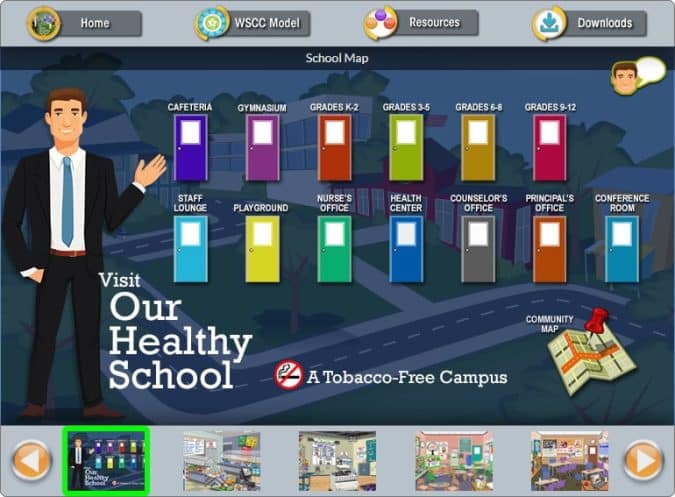
Escambia County Children’s Trust will soon launch a new program, Healthy School Escambia, based on the Centers for Disease Control and Prevention’s Whole School, Whole Community, Whole Child model.
- Inweekly found one school district in Texas, Fort Bend Independent School District, that has implemented the CDC model similarly, but Texas district officials refused to discuss any specifics.
- To see the WSCC model in action, visit the CDC Virtual Healthy School. Note: it appears to be more basic than the Trust’s plan.
Healthy Schools Escambia
The Children’s Trust will test the CDC’s model on two Title I schools, Global Learning Academy and O.J. Semmes Elementary. Trust executive director Lindsey Cannon estimated services for each school will cost about $450,000 as part of the Healthy Schools Escambia Initiative.
- The Trust announced an invitation to bid on its website in June, with the goal of securing providers to “enhance the health and well-being of students across Escambia County by creating environments that support healthy lifestyles and educational success.” The bidding process closed last Friday.
The invitation to bid included a lead applicant. United Way of West Florida (UWWF) applied to be the lead and is expected to be selected for the role. If approved by the Children’s Trust board of directors, the contract for the providers will begin on Nov. 1.
UWWF CEO Laura Gilliam said the lead applicant is positioned to either implement the programs on its own or bring in partners. She said United Way is already working with partners to identify roles and address the needs of the schools.
- “United Way has a lot of relationships with lots of entities in the community so it’s a natural role for us to play,” she said. “It’s a natural fit and obviously education is such a foundation and basis of so many things. We want to see what we can do to help improve that.”
Gilliam described the CDC model as “really interesting” with the potential to be “really effective.” She said assessments of the students and their families will shape the model and that collaboration among the providers will be crucial for success.
- “The bottom line is you’ve got to know what the students’ and the school’s and the families’ needs are,” Gilliam said. “… You’ve got to hear it from the folks you’re trying to serve. There’s the assessment piece.”
The CDC model emphasizes the community supporting schools through health and academic achievement connections and evidence-based school policies and practices. The model includes 10 components ranging from physical activity to counseling, psychological and social services to family engagement.
- “You might not utilize all of them in one school,” Cannon said of the components. “We’d like to get to that but at first it will probably be the basics.”
Cannon said the Trust will partner with the providers to deliver comprehensive programs focused on nutrition, physical activity, mental health and overall wellness. Education is notably absent from that list.
“I don’t think there’s a ton of us in the nonprofit world who are experts in education,” Cannon said. “We have to rely on the school district to tell us what they need.”
Escambia County Public Schools Supt. Keith Leonard serves on the Trust board and said the Healthy Schools initiative provides “different opportunities for success.” According to Leonard, the CDC model shares some of the same components as the Children’s Home Society’s Community Partnership School Model. The Community Partnership School Model is used at three Escambia County schools in C.A. Weis Elementary, Bellview Middle School and Pine Forest High School.
DIG DEEPER: Before joining the Trust earlier this year, Cannon served as the executive director of the Children’s Home Society of Florida for the western and Emerald Coast region. She said the Trust could not expand the Community Partnership School Model because it’s proprietary and funded through the State Legislature.
Few schools or districts use the CDC model. One exception is Fort Bend Independent School District in Texas. Fort Bend grades out as a B, scoring 89 out of a possible 100 points in the Texas School Report Cards. The school district includes 82 schools and an enrollment of nearly 77,000, roughly twice the number of students who attend Escambia County Public Schools.
Fort Bend is extremely diverse, with about 28% of the student population Black, Hispanic and Asian populations each account for about 27%, and white students follow at about 15%. The county is the wealthiest in Texas, yet nearly half of the students in Fort Bend ISD qualify as economically disadvantaged, topping Escambia County by about five percentage points in that distinction.
Inweekly requested an interview with Fort Bend Supt. Marc Smith, but he declined to give his assessment of the CDC model. Sherry Williams, the school district’s director of strategic communications, confirmed that Fort Bend “aligns with the CDC model for Whole Child Health.”



